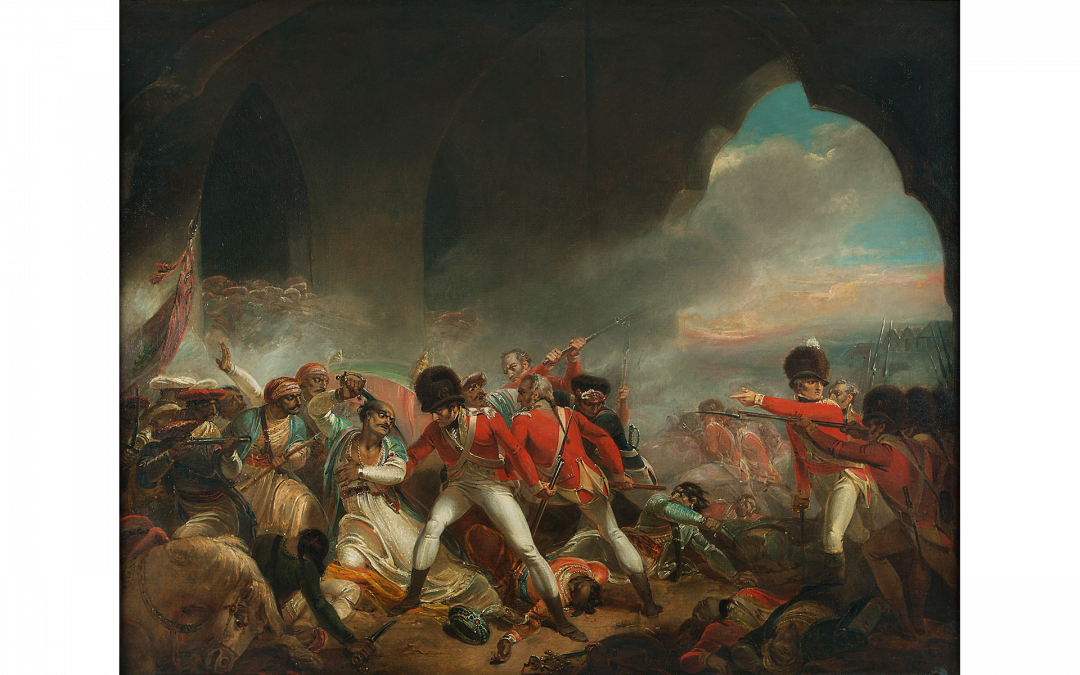The Last Effort and Fall of Tippoo Sultaun
| Story Text | [{"record_id":"0","storytext":"The Last Effort and Fall of Tippoo Sultaun was made by British artist Henry Singleton (1766-1839) for British audiences. The painting had remained in Britain since the time it was painted, shortly after the event that it depicts, which happened in 1799, until recently when it was brought to India.","initialize":"true","storytextauthor":""},{"record_id":"1","storytext":"At the time, Singleton was an up-and-coming history painter in England, who never set foot in India. But alongside others like Mather Brown, Thomas Stothard and Robert Ker Porter, he too cashed in on the excitement surrounding Tipu Sultan and his death and made images of the besieging of Srirangapatna. ","initialize":"true","storytextauthor":""},{"record_id":"2","storytext":"In this oil painting that was also turned into a monochrome engraved print for wider dissemination, Singleton provides a detailed account of Tipu\u2019s defeat and death, even though it was historically inaccurate.","initialize":"true","storytextauthor":""},{"record_id":"3","storytext":"Tipu himself is shown, left of centre, having lost his turban and seemingly in mid fall. He raises his sabre over his head as a last defence against the British officer who looms over him and whose unseen right hand we may suppose is plunging a dagger into Tipu\u2019s side. ","initialize":"true","storytextauthor":""},{"record_id":"4","storytext":"Behind this officer stands another, poised to pierce Tipu with his bayonetted rifle. And just to ensure that there is no room for doubt about the outcome, Singleton provides back-up in the form of a third officer, to the right, directing two riflemen where to aim their fire.","initialize":"true","storytextauthor":""},{"record_id":"5","storytext":"Behind Tipu his companions cower before the overwhelming rush of redcoats.","initialize":"true","storytextauthor":""},{"record_id":"6","storytext":"All of this is entirely imaginary: no one on the British side saw the moment when Tipu fell in battle, and his body was only discovered after its conclusion.","initialize":"true","storytextauthor":""},{"record_id":"7","storytext":"He was more likely killed by a distant shot than in a close encounter. Singleton shows us not how Tipu fell but how a British audience would like him to have done. ","initialize":"true","storytextauthor":""},{"record_id":"8","storytext":"The details of dress and architecture lend the scene credibility, and it was circulated widely. The work was engraved by N. Schiavonetti and published in several editions, in 1801 and 1802, not only in England but also in France, with bilingual captions.","initialize":"true","storytextauthor":""},{"record_id":"9","storytext":"Singleton had incorrectly given Tipu a hairline, which was fixed in the monochrome print. It should be noted that Singleton did not go back to the painting to correct his mistake. It was equally likely that the painting was travelling and he did not have the opportunity to do so, or perhaps he intentionally chose not to retouch the original painting. ","initialize":"true","storytextauthor":""},{"record_id":"10","storytext":"In the pamphlets and literature that consolidated multiple military war accounts of from this period, a fascinating story about the central figure in the painting emerged. Since looting and theft from Tipu\u2019s courts was rampant, this figure has been equated to an unknown thief attempting to steal Tipu\u2019s kamarbandh instead of valiantly attempting to slay the Sultan. ","initialize":"true","storytextauthor":""},{"record_id":"11","storytext":"Curiously, there were no British soldiers who came forward and claimed to have killed Tipu. ","initialize":"true","storytextauthor":""},{"record_id":"12","storytext":"Tipu Sultan presented the most powerful challenge to the might of Britain\u2019s East India Company in the period of its greatest territorial expansion. Building on the legacy of his father, Haider Ali, during his relatively short reign as ruler of the kingdom of Mysore (1782-99), Tipu proved himself to be an efficient and firm governor of his state, flexible in forming alliances but ready to be aggressive towards his neighbours.","initialize":"true","storytextauthor":""},{"record_id":"13","storytext":"The Siege of Srirangapatna extinguished the most formidable threat that the British had faced in India up till then; and they would not face anything else on the same scale again until the Revolt of 1857.","initialize":"true","storytextauthor":""},{"record_id":"14","storytext":"Painted by British artists for the enjoyment of British audiences, \u2018history paintings\u2019 were not nearly historically accurate, but tried to project the superiority\u2014military or otherwise\u2014of the Crown and the kingdom, of which Singleton\u2019s artwork is a key example. ","initialize":"true","storytextauthor":""}] |
|---|---|
| XY Coords | [{"record_id":"0","xcoord":"75","ycoord":"53","initialize":"true"},{"record_id":"1","xcoord":"40","ycoord":"66","initialize":"true"},{"record_id":"2","xcoord":"33","ycoord":"67","initialize":"true"},{"record_id":"3","xcoord":"47","ycoord":"58","initialize":"true"},{"record_id":"4","xcoord":"27","ycoord":"57","initialize":"true"},{"record_id":"5","xcoord":"83","ycoord":"70","initialize":"true"},{"record_id":"6","xcoord":"66","ycoord":"61","initialize":"true"},{"record_id":"7","xcoord":"68","ycoord":"16","initialize":"true"},{"record_id":"8","xcoord":"36","ycoord":"55","initialize":"true"},{"record_id":"9","xcoord":"24","ycoord":"44","initialize":"true"},{"record_id":"10","xcoord":"54","ycoord":"50","initialize":"true"},{"record_id":"11","xcoord":"25","ycoord":"85","initialize":"true"},{"record_id":"12","xcoord":"63","ycoord":"76","initialize":"true"},{"record_id":"13","xcoord":"54","ycoord":"89","initialize":"true"}] |
| Art Artist Names Single | Henry Singleton |
Write Your Own Review





